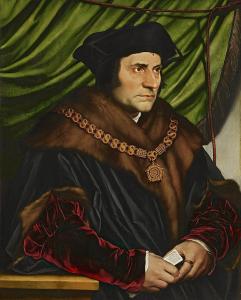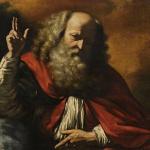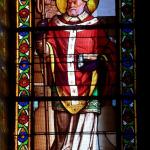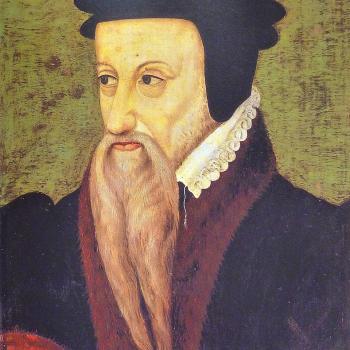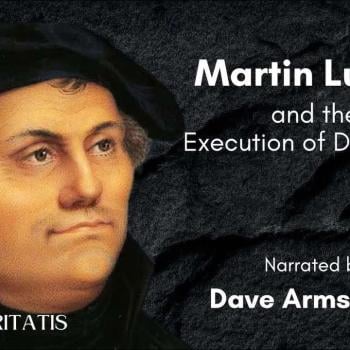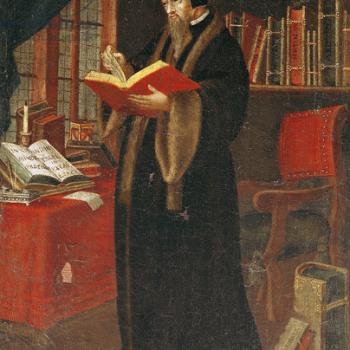[originally written / edited in 1991]
The most famous English martyr in the 16th century was St. Thomas More (1478-1535), the universally admired humanist, lawyer, Lord Chancellor, and scholar probably second only to Erasmus; he had written the famous Utopia. This remarkable man was immortalized in our own time by the movie A Man For All Seasons (1966). It is well worthwhile to stop and take a look at this great hero, filled with the highest integrity:
More was a delightful person, one of the simplest and most human saints in the calendar. There was nothing stiff or severe or morose about him. He radiated the joyous tranquility and spiritual goodness of a man who, having once resolutely opted for heaven, is able to offer the world below a never-ending peace of mind . . . At the same time he was the perfect type of humanist, his mind and soul packed with noble thoughts; a man well abreast of all the discoveries or his age, and passionately interested in new ideas. His love of knowledge and the arts took him to the lengths of turning his own house into a miniature Platonic Academy . . . This is the saint we love so well, and whom we long to resemble . . .
His religion corresponded with his noble character. He was tolerant towards his fellow men, completely free from dogmatism, but resolute in his principles. Christian humanism . . . had no more accomplished representative than More . . .
At the beginning More, like Erasmus, had viewed the great stir and commotion at Wittenberg with a certain amount of amused delight. But it was not very long before the utterances of Luther shocked and disgusted him; in 1529 he had condemned them in his spirited little masterpiece, Dialogue On Heresies; then, in his Supplication Of Souls, he pointed out the falsehood of the Lutheran view of monastic vows and indulgences. He had sustained a lively argument against the Protestant propaganda of Tyndale, in which he had shown that the alleged return to primitive doctrine was a false enticement to the unwary, and that Tradition was simply the adaptation to changing kinds of society of one single, fundamental message.
A man of this stamp was obviously not made to participate in the king’s game and accept the wholly personal reasons which had led Henry VIII to disobey the laws of the Church. (Henri Daniel-Rops, The Protestant Reformation, vol. 2, tr. Audrey Butler, Garden City, New York: Doubleday Image, 1961, 246-248)
He inherited, and stepped naturally into, the greatest honours and legal position. He abandoned them all and died for the Faith . . . More was . . . eminent throughout Europe for his scholarship, a great international figure . . .
He had the temptations which beset the intellectual man, the sensitive scholar, the successful worldly figure. To these temptations he was in danger of yielding, and had partly yielded. He triumphed over them, and that in a fashion quite peculiar to himself. That is why he is so glorious, and that is why he is so great an example . . . He acted in complete isolation, and he laid down his life for one small strict point of Catholic doctrine only; and, what is more, a point of doctrine on which he himself had long doubted . . . He was not supported by any sympathy for himself even among his nearest. He was not supported by the nature of his own mind, which had been hesitant and, even in essential matters, changeable. He gave himself up as a victim in spite of all those things which would made 999 men out of a thousand deceive themselves that they might be doing right in yielding. This is the heroic and almost unique quality in More.
To begin with let it clearly be understood that St. Thomas More was a reformer . . . The whole of Christendom was moved also by a spirit which caused the younger men especially, and more especially the more intelligent and emotional of the younger men, to denounce the corruptions of the time, the errors of legend, the exaggeration of certain practices and the doubtfulness or demonstrable falsity of many shrines and relics.
Sir Thomas More was just of the kind who would . . . have drifted from step to step, beginning with indignation against abuses, and ending with the full heretical position into which nearly all such men later fell.
He was indignant against the social order of his time as well as against the abuses of the Church. What is more, his indignation inspired him to wit, and to very high literary efforts; and men who discover such talents in themselves while they are still young nearly always fall into the temptation of becoming increasingly revolutionary as time proceeds . . . More should, therefore, according to the order of nature, have become ultimately a violent opponent not only of the social order but of that Divine unity in the Church for which he laid down his life. All his character seemed to point that way . . .
He was absolutely alone . . . nothing promised in the future . . . nothing in the traditions of his habits and life, to nerve him for what he did. And yet he did it.
In order to understand how extraordinary the case is, and what a marvelous example it is of resolution and vision combined, let us appreciate exactly what it was that More defended at the cost of his life.
He died for the principle, that ultimately, in spiritual matters, the Pope was the Head of Christendom – a principle which all Christendom was debating, and had been debating for more than a hundred years . . . Yet it was for that very point, which he had himself doubted, that he consented to die . . . He had what is called “Heroic Faith.” (Hilaire Belloc, Characters of the Reformation, Garden City, New York: Doubleday Image, 1958, 62-67, 69)
When ordered to swear to the Act of Succession, he tried to evade the issue; but the king’s soldiers came to arrest him, and on 17th April 1534 he was sent to the Tower. For fourteen months he remained in prison . . . On 1st July 1535 he was condemned to death in Westminster Hall where he had so often dispensed justice in the past . . . Thomas More rose to his feet, very calm, and told this court of flunkeys and time-servers why he was going to his death:
I will now in discharge of my conscience speak my mind plainly and freely touching my indictment and your Statute withal. And forasmuch as this indictment is grounded upon an Act of Parliament directly repugnant to the laws of God and His holy Church, the supreme government of which . . . may no temporal prince presume by any law to take upon him, as rightfully belonging to the See of Rome, a spiritual preeminence by the mouth of Our Saviour Himself . . . only to St. Peter and his successors bishops of the same See . . .
Very and pure necessity . . . enforces me to speak so much. Wherein I call and appeal to God, whose only sight pierces into the very depth of man’s heart, to be my witness . . . the Church is one and indivisible, and you have no authority to make a law which infringes Christian unity.
Only the executioner could reply to words like these. The last word was his . . . This judicial murder provoked the strongest reactions throughout Europe . . . All protests were of no avail against an autocrat like Henry. He confined himself to telling other rulers that he had merely punished traitors, and had fourteen Anabaptists burned at the stake to demonstrate his own religious zeal . . . Stapleton relates how Henry was brought the news of More’s execution . . . He sprang to his feet, quite pale, overcome by an absurd remorse. Looking blackly at Anne Boleyn, he shouted: “You are responsible!” The blood of this new John the Baptist was soon to spill over the Tudor Herodias. A year later, to the very day, she too would mount the scaffold steps. (Daniel-Rops, ibid., 248-250)
On July 6th, More was led to the scaffold. He retained his dignity and humor to the end:
He said to an attendant, “I pray you . . . see me safe up, and for my coming down let me shift for myself.” The executioner asked his forgiveness; More embraced him . . . More begged the spectators to pray for him, and to “bear witness that he . . . suffered death in and for the faith of the Holy Catholic Church.” He then asked them to pray for the King . . . and he protested that he died being the King’s good servant, but God’s first. He repeated the 51st Psalm. Then he laid his head upon the block, carefully arranging his long gray beard that it should take no harm: “pity that should be cut,” he said, “that has not committed treason.” His head was affixed to London Bridge . . .
A wave of terror passed through an England that now realized the resolute mercilessness of the King, and a shudder of horror ran through Europe. Erasmus felt that he himself had died, for “we had but one soul between us”; he said that he had now no further wish to live, and a year later he too was dead. (Will Durant, The Reformation, New York: Simon & Schuster, 1957, 558)
Jonathan Swift (1667-1745), a priest in the Church of England and famous satirical author of Gulliver’s Travels (1726), thought More the man “of the greatest virtue this kingdom ever produced.” (Durant, ibid., 558)
On the 400th anniversary of their execution the Church of Rome enrolled Thomas More and John Fisher among her saints. (Durant, ibid., 558)
***
I include excerpts from St. Thomas More’s writings in my book, Classic Catholic Biblical Apologetics: 1525-1925 (Feb. 2012, 246 pages)
***
Practical Matters: Perhaps some of my 4,000+ free online articles (the most comprehensive “one-stop” Catholic apologetics site) or fifty books have helped you (by God’s grace) to decide to become Catholic or to return to the Church, or better understand some doctrines and why we believe them.
Or you may believe my work is worthy to support for the purpose of apologetics and evangelism in general. If so, please seriously consider a much-needed financial contribution. I’m always in need of more funds: especially monthly support. “The laborer is worthy of his wages” (1 Tim 5:18, NKJV). 1 December 2021 was my 20th anniversary as a full-time Catholic apologist, and February 2022 marked the 25th anniversary of my blog.


